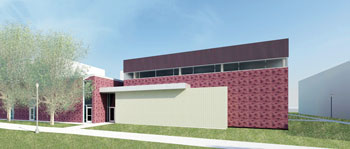
|
Construction began in October and will finish in late spring for a $3 million addition to Mason Hall to provide expanded and improved rehearsal space for the School of Music.
The new addition is situated between rooms 1051 and 1053, which were built in 1961 as large group performing/recording areas for the School of Music, and King Concert Hall. It will include two rooms, a larger 60- by 66-foot space which will face Dods Hall, and a smaller 53- by 62-foot space which will face the amphitheatre and Reed Library. Plans are for the front facades to match the existing brick of the adjacent sides of Mason Hall.
The new rooms will be separated from the existing rehearsal space by a corridor. Eventually, Room 1053 will become a storage area and the older existing sound recording studio will be removed. The addition will also serve as an enabling project to the upcoming planned addition to Rockefeller Arts Center, providing a little “surge space” for rehearsals if necessary for the Department of Theatre and Dance.
In addition to new and improved rehearsal/performance space, it will address sound volume and quality issues as recommended by engineers. Director of Bands Paula Holcomb noted, “We are so excited to have these rooms available for the students! As a result of an extensive and diligent partnership with the acoustical and architectural design teams, the students will be able to hear musicians across the ensemble so they can interact with, support and respond to each other as they create passionate music.”
Designer/architect Foit-Albert Associates and SLR Contracting & Service Co., Inc., both of Buffalo, N.Y., are joined by acoustical consultant AVL Designs, Inc. of Penfield, N.Y., in forming the construction team, which is being guided by Markus Kessler, SUNY Fredonia’s director of Facilities Planning.
School of Music Director Karl Boelter added, “As our School of Music has evolved, the size of ensembles and the range of the repertoire have grown. The existing rooms simply became too small for both the number of students in the instrumental groups and the amount of sound that they create. These rooms will be two and three times the size of our existing spaces, making it possible for the ensembles to have full flexibility in designing a current and relevant curriculum for the way our school is now and likely to develop in the future.”



